Substantially Greater Carbon Emissions Estimated Based on Annual Land-Use Transition Data
Abstract
:1. Introduction
2. Materials and Methods
2.1. Study Area
2.2. LULCC Data Resource
2.3. Research Procedure
2.3.1. Procedure of Producing LULCC
2.3.2. Carbon Cycle Modeling Approach
2.3.3. Carbon Stock and Flows
2.3.4. Model Initialization
3. Results
3.1. Land-Cover Change in CBW
3.2. Carbon Stock Trends of CBW
3.3. Carbon Stock and Flux Caused by LULCC
3.4. Impacts of Time Density of LULC on Land-Cover Change and Carbon Flux
4. Discussion
5. Conclusions
Author Contributions
Funding
Acknowledgments
Conflicts of Interest
References
- Houghton, R.A.; House, J.; Pongratz, J.; Van Der Werf, G.; DeFries, R.; Hansen, M.; Quéré, C.L.; Ramankutty, N. Carbon emissions from land use and land-cover change. Biogeosciences 2012, 9, 5125–5142. [Google Scholar] [CrossRef] [Green Version]
- de Noblet-Ducoudré, N.; Boisier, J.-P.; Pitman, A.; Bonan, G.; Brovkin, V.; Cruz, F.; Delire, C.; Gayler, V.; Van den Hurk, B.; Lawrence, P. Determining robust impacts of land-use-induced land cover changes on surface climate over North America and Eurasia: Results from the first set of LUCID experiments. J. Clim. 2012, 25, 3261–3281. [Google Scholar] [CrossRef] [Green Version]
- Lawrence, P.J.; Feddema, J.J.; Bonan, G.B.; Meehl, G.A.; O’Neill, B.C.; Oleson, K.W.; Levis, S.; Lawrence, D.M.; Kluzek, E.; Lindsay, K. Simulating the biogeochemical and biogeophysical impacts of transient land cover change and wood harvest in the Community Climate System Model (CCSM4) from 1850 to 2100. J. Clim. 2012, 25, 3071–3095. [Google Scholar] [CrossRef] [Green Version]
- Pitman, A.; de Noblet-Ducoudré, N.; Avila, F.; Alexander, L.; Boisier, J.-P.; Brovkin, V.; Delire, C.; Cruz, F.; Donat, M.; Gayler, V. Effects of land cover change on temperature. Earth Syst. Dyn. 2012, 3, 213–231. [Google Scholar] [CrossRef] [Green Version]
- Lafleur, P.M.; McCaughey, J.H.; Joiner, D.W.; Bartlett, P.A.; Jelinski, D.E. Seasonal trends in energy, water, and carbon dioxide fluxes at a northern boreal wetland. J. Geophys. Res. Atmos. 1997, 102, 29009–29020. [Google Scholar] [CrossRef]
- Ramachandra, T.V.; Setturu, B.; Rajan, K.S.; Subash Chandran, M.D. Stimulus of developmental projects to landscape dynamics in Uttara Kannada, Central Western Ghats. Egypt. J. Remote Sens. Space Sci. 2016, 19, 175–193. [Google Scholar] [CrossRef] [Green Version]
- Lira, P.K.; Tambosi, L.R.; Ewers, R.M.; Metzger, J.P. Land-use and land-cover change in Atlantic Forest landscapes. For. Ecol. Manag. 2012, 278, 80–89. [Google Scholar] [CrossRef]
- Homer, C.; Dewitz, J.; Yang, L.; Jin, S.; Danielson, P.; Xian, G.; Coulston, J.; Herold, N.; Wickham, J.; Megown, K. Completion of the 2011 national land cover database for the conterminous United States–representing a decade of land cover change information. Photogramm. Eng. Remote Sens. 2015, 81, 345–354. [Google Scholar]
- Rogan, J.; Franklin, J.; Roberts, D.A. A comparison of methods for monitoring multitemporal vegetation change using thematic mapper imagery. Remote Sens. Environ. 2002, 80, 143–156. [Google Scholar] [CrossRef]
- Zhu, Z.; Woodcock, C.E. Continuous change detection and classification of land cover using all available Landsat data. Remote Sens. Environ. 2014, 144, 152–171. [Google Scholar] [CrossRef] [Green Version]
- Brown, J.F.; Tollerud, H.J.; Barber, C.P.; Zhou, Q.; Dwyer, J.L.; Vogelmann, J.E.; Loveland, T.R.; Woodcock, C.E.; Stehman, S.V.; Zhu, Z. Lessons learned implementing an operational continuous United States national land change monitoring capability: The Land Change Monitoring, Assessment, and Projection (LCMAP) approach. Remote Sens. Environ. 2020, 238, 111356. [Google Scholar] [CrossRef]
- Pengra, B.W.; Stehman, S.V.; Horton, J.A.; Dockter, D.J.; Schroeder, T.A.; Yang, Z.; Cohen, W.B.; Healey, S.P.; Loveland, T.R. Quality control and assessment of interpreter consistency of annual land cover reference data in an operational national monitoring program. Remote Sens. Environ. 2020, 238, 111261. [Google Scholar] [CrossRef]
- Zhu, Z.; Woodcock, C.E. Object-based cloud and cloud shadow detection in Landsat imagery. Remote Sens. Environ. 2012, 118, 83–94. [Google Scholar] [CrossRef]
- Zhu, Z. Change detection using landsat time series: A review of frequencies, preprocessing, algorithms, and applications. ISPRS J. Photogramm. Remote Sens. 2017, 130, 370–384. [Google Scholar] [CrossRef]
- Zhu, Z.; Gallant, A.L.; Woodcock, C.E.; Pengra, B.; Olofsson, P.; Loveland, T.R.; Jin, S.; Dahal, D.; Yang, L.; Auch, R.F. Optimizing selection of training and auxiliary data for operational land cover classification for the LCMAP initiative. ISPRS J. Photogramm. Remote Sens. 2016, 122, 206–221. [Google Scholar] [CrossRef] [Green Version]
- Le Quéré, C.; Andrew, R.M.; Friedlingstein, P.; Sitch, S.; Pongratz, J.; Manning, A.C.; Korsbakken, J.I.; Peters, G.P.; Canadell, J.G.; Jackson, R.B.; et al. Global carbon budget 2017. Earth Syst. Sci. Data 2018, 10, 405–448. [Google Scholar] [CrossRef] [Green Version]
- Sitch, S.; Huntingford, C.; Gedney, N.; Levy, P.; Lomas, M.; Piao, S.; Betts, R.; Ciais, P.; Cox, P.; Friedlingstein, P. Evaluation of the terrestrial carbon cycle, future plant geography and climate-carbon cycle feedbacks using five Dynamic Global Vegetation Models (DGVMs). Glob. Chang. Biol. 2008, 14, 2015–2039. [Google Scholar] [CrossRef]
- Pongratz, J.; Reick, C.H.; Houghton, R.; House, J. Terminology as a key uncertainty in net land use and land cover change carbon flux estimates. Earth Syst. Dyn. 2014, 5, 177–195. [Google Scholar] [CrossRef] [Green Version]
- Sohl, T.L.; Sleeter, B.M.; Sayler, K.L.; Bouchard, M.A.; Reker, R.R.; Bennett, S.L.; Sleeter, R.R.; Kanengieter, R.L.; Zhu, Z. Spatially explicit land-use and land-cover scenarios for the great plains of the United States. Agric. Ecosyst. Environ. 2012, 153, 1–15. [Google Scholar] [CrossRef] [Green Version]
- Daniel, C.J.; Sleeter, B.M.; Frid, L.; Fortin, M.J. Integrating continuous stocks and flows into state-and-transition simulation models of landscape change. Methods Ecol. Evol. 2017. [Google Scholar] [CrossRef] [Green Version]
- Liu, J.; Zhu, Z.; Sleeter, B.M.; Zhu, Q.; Soulard, C.E. Assessing Wetland Methane Emission Changes in the Conterminous U.S. from 1973 to 2010. Available online: https://ui.adsabs.harvard.edu/abs/2014AGUFM.B31I..07L/abstract (accessed on 1 February 2020).
- Sleeter, B.M.; Liu, J.; Daniel, C.; Frid, L.; Zhu, Z. An integrated approach to modeling changes in land use, land cover, and disturbance and their impact on ecosystem carbon dynamics: A case study in the Sierra Nevada Mountains of California. AIMS Environ. Sci. 2015, 2, 577–606. [Google Scholar] [CrossRef]
- Goetz, S.J.; Jantz, C.A.; Prince, S.D.; Smith, A.J.; Wright, R.; Varlyguin, D. Integrated analysis of ecosystem interactions with land use change: The Chesapeake Bay watershed. Ecosyst. Land Use Chang. 2004, 153, 263–275. [Google Scholar]
- Jantz, P.; Goetz, S.; Jantz, C. Urbanization and the loss of resource lands in the Chesapeake Bay watershed. Environ. Manag. 2005, 36, 808–825. [Google Scholar] [CrossRef] [PubMed]
- Claggett, P.R.; Jantz, C.A.; Goetz, S.J.; Bisland, C. Assessing development pressure in the Chesapeake Bay watershed: An evaluation of two land-use change models. Environ. Monit. Assess. 2004, 94, 129–146. [Google Scholar] [CrossRef] [PubMed]
- Foley, J.A.; Prentice, I.C.; Ramankutty, N.; Levis, S.; Pollard, D.; Sitch, S.; Haxeltine, A. An integrated biosphere model of land surface processes, terrestrial carbon balance, and vegetation dynamics. Glob. Biogeochem. Cycles 1996, 10, 603–628. [Google Scholar] [CrossRef]
- Liu, J.; Price, D.T.; Chen, J.M. Nitrogen controls on ecosystem carbon sequestration: A model implementation and application to Saskatchewan, Canada. Ecol. Model. 2005, 186, 178–195. [Google Scholar] [CrossRef]
- Zhou, D.; Liu, S.; Oeding, J.; Zhao, S. Forest cutting and impacts on carbon in the eastern United States. Sci. Rep. 2013, 3, 3547. [Google Scholar] [CrossRef] [Green Version]
- Schreiner, E.J. Mini-Rotation Forestry; US Northeastern Forest Experiment Station: Upper Darby, WI, USA, 1970; Volume 174, pp. 2–3. [Google Scholar]
- Houghton, R.A.; Hackler, J.L.; Lawrence, K.T. The US carbon budget: Contributions from land-use change. Science 1999, 285, 574–578. [Google Scholar] [CrossRef]
- Klein Goldewijk, K.; Beusen, A.; Van Drecht, G.; De Vos, M. The HYDE 3.1 spatially explicit database of human-induced global land-use change over the past 12,000 years. Glob. Ecol. Biogeogr. 2011, 20, 73–86. [Google Scholar] [CrossRef]
- Houghton, R.; Nassikas, A.A. Global and regional fluxes of carbon from land use and land cover change 1850–2015. Glob. Biogeochem. Cycles 2017, 31, 456–472. [Google Scholar] [CrossRef]
- Lister, T.W.; Perdue, J.; Barnett, C.; Butler, B.; Crocker, S.; Domke, G.; Griffith, D.; Hatfield, M.; Kurtz, C.; Lister, A. Maryland’s forests 2008. In Resour. Bull. NRS-58. Newtown Square; US Department of Agriculture, Forest Service, Northern Research Station: Madison, WI, USA, 2011; Volume 58, pp. 1–60. [Google Scholar] [CrossRef] [Green Version]
- Hutyra, L.R.; Yoon, B.; Hepinstall-Cymerman, J.; Alberti, M. Carbon consequences of land cover change and expansion of urban lands: A case study in the Seattle metropolitan region. Landsc. Urban Plan. 2011, 103, 83–93. [Google Scholar] [CrossRef]
- Hollister, J.W.; Gonzalez, M.L.; Paul, J.F.; August, P.V.; Copeland, J.L. Assessing the accuracy of national land cover dataset area estimates at multiple spatial extents. Photogramm. Eng. Remote Sens. 2004, 70, 405–414. [Google Scholar] [CrossRef]
- Wulder, M.A.; Ortlepp, S.M.; White, J.C.; Maxwell, S. Evaluation of Landsat-7 SLC-off image products for forest change detection. Can. J. Remote Sens. 2008, 34, 93–99. [Google Scholar] [CrossRef]
- Gong, P.; Wang, J.; Yu, L.; Zhao, Y.; Zhao, Y.; Liang, L.; Niu, Z.; Huang, X.; Fu, H.; Liu, S. Finer resolution observation and monitoring of global land cover: First mapping results with Landsat TM and ETM + data. Int. J. Remote Sens. 2013, 34, 2607–2654. [Google Scholar] [CrossRef] [Green Version]
- Chen, J.M.; Gonsamo, A.; Chen, B.; Liu, J.; CRC; FRSC. Assessing Climate Change Impact on Carbon Cycles in the Ontario’s Far North Ecosystems; Ontario Ministry of the Enviroment and Climate Change: Etobicoke, ON, Canada, 2015.
- Zhou, Q.; Rover, J.; Brown, J.; Worstell, B.; Howard, D.; Wu, Z.; Gallant, A.L.; Rundquist, B.; Burke, M. Monitoring landscape dynamics in central US Grasslands with harmonized Landsat-8 and sentinel-2 time series data. Remote Sens. 2019, 11, 328. [Google Scholar] [CrossRef] [Green Version]
- Hockstad, L.; Hanel, L. Inventory of US Greenhouse Gas Emissions and Sinks; Environmental Protection Agency: Washington, DC, USA, 2018. [CrossRef]
- Hurtt, G.; Pacala, S.W.; Moorcroft, P.R.; Caspersen, J.; Shevliakova, E.; Houghton, R.; Moore, B. Projecting the future of the US carbon sink. Proc. Natl. Acad. Sci. USA 2002, 99, 1389–1394. [Google Scholar] [CrossRef] [PubMed] [Green Version]
- Pan, Y.; Birdsey, R.A.; Fang, J.; Houghton, R.; Kauppi, P.E.; Kurz, W.A.; Phillips, O.L.; Shvidenko, A.; Lewis, S.L.; Canadell, J.G. A large and persistent carbon sink in the world’s forests. Science 2011, 333, 988–993. [Google Scholar] [CrossRef] [Green Version]
- Liu, J.; Sleeter, B.M.; Zhu, Z.; Loveland, T.R.; Sohl, T.; Howard, S.M.; Key, C.H.; Hawbaker, T.; Liu, S.; Reed, B.; et al. Critical land change information enhances understanding of carbon balance in the U.S. Glob. Chang. Biol. 2020. [Google Scholar] [CrossRef]
- Mendelssohn, I.A.; Marcellus, K.L. Angiosperm production of three Virginia marshes in various salinity and soil nutrient regimes. Chesap. Sci. 1976, 17, 15–23. [Google Scholar] [CrossRef]
- Turner, R.E. Geographic variations in salt marsh macrophyte production: A review. Contrib. Mar. Sci. 1976, 20, 47–68. [Google Scholar]
- Doumlele, D.G. Primary production and seasonal aspects of emergent plants in a tidal freshwater marsh. Estuaries 1981, 4, 139–142. [Google Scholar] [CrossRef]
- Heinsch, F.A.; Reeves, M.; Votava, P.; Kang, S.; Milesi, C.; Zhao, M.; Glassy, J.; Jolly, W.M.; Loehman, R.; Bowker, C.F. Gpp and npp (mod17a2/a3) products nasa modis land algorithm. In Mod17 User’s Guide; University of Montana: Missoula, MT, USA, 2003; pp. 1–57. [Google Scholar]
- Parton, W.J.; Hartman, M.; Ojima, D.; Schimel, D. DAYCENT and its land surface submodel: Description and testing. Glob. Planet. Chang. 1998, 19, 35–48. [Google Scholar] [CrossRef]
- Sakalli, A. Impacts of climate change on net primary production: A modelling study at pan-european scale. Appl. Ecol. Environ. Res. 2017, 15, 1–15. [Google Scholar] [CrossRef]
- Xu, W.; Hays, B.; Fayrer-Hosken, R.; Presotto, A. Modeling the distribution of African Savanna elephants in Kruger National Park: An application of multi-scale globeland30 data. Int. Arch. Photogramm. Remote Sens. Spat. Inf. Sci. 2016, 41. [Google Scholar] [CrossRef] [Green Version]
- Zhu, L.; Sun, Y.; Shi, R.; La, Y.; Peng, S. Exploiting cosegmentation and Geo-Eco zoning for land cover product updating. Photogramm. Eng. Remote Sens. 2019, 85, 597–611. [Google Scholar] [CrossRef]
- Bartholome, E.; Belward, A.S. GLC2000: A new approach to global land cover mapping from earth observation data. Int. J. Remote Sens. 2005, 26, 1959–1977. [Google Scholar] [CrossRef]

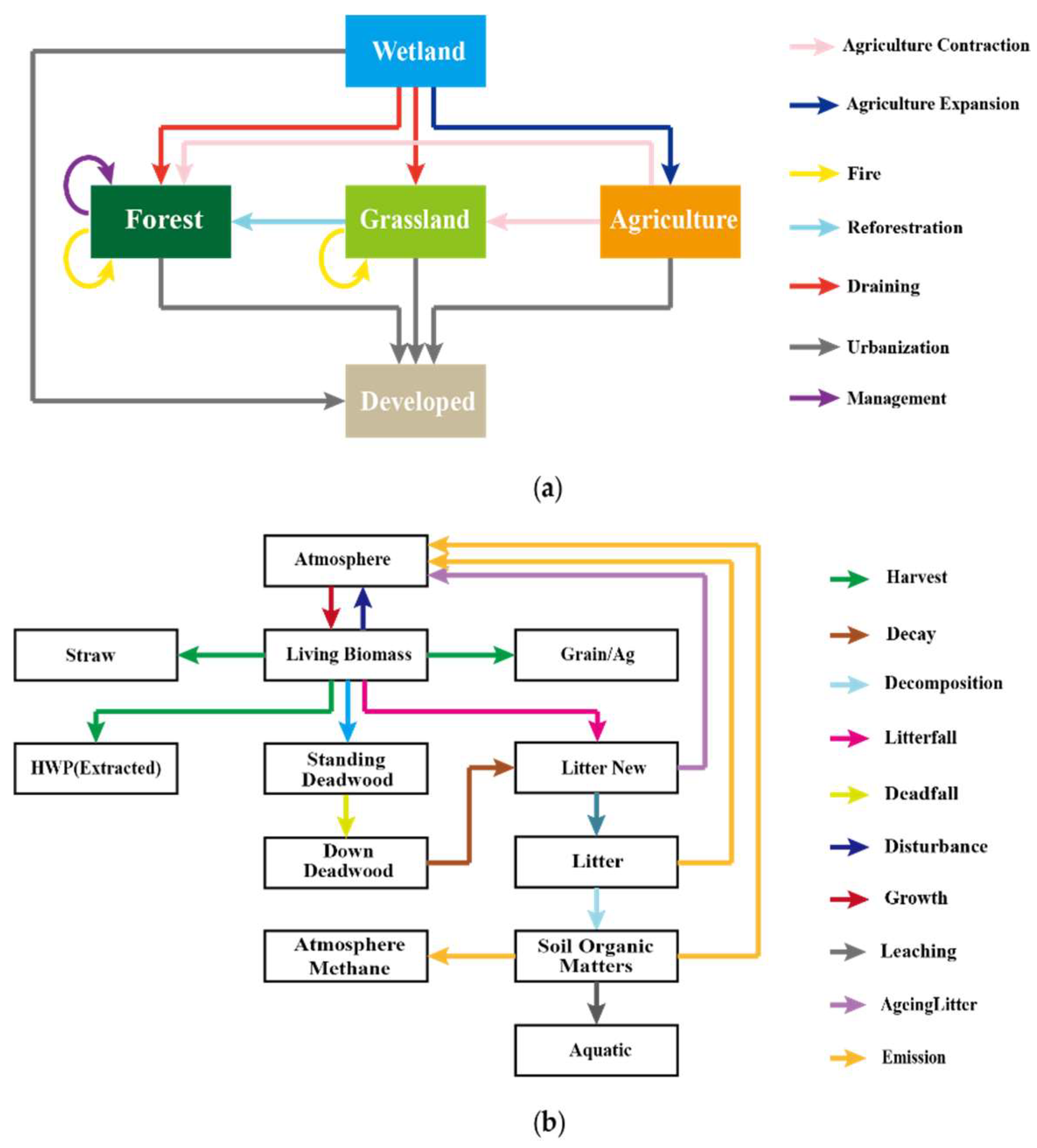


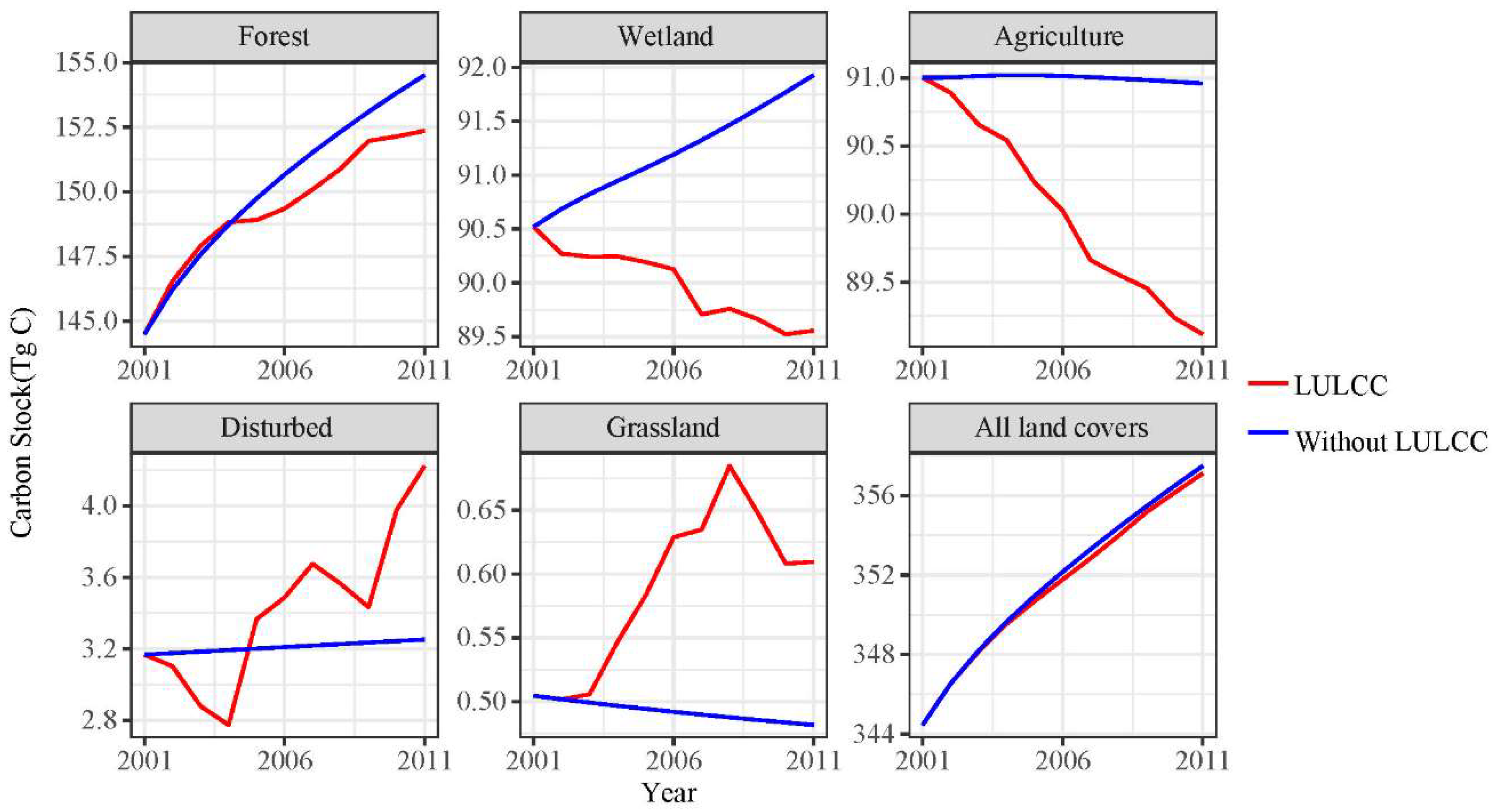
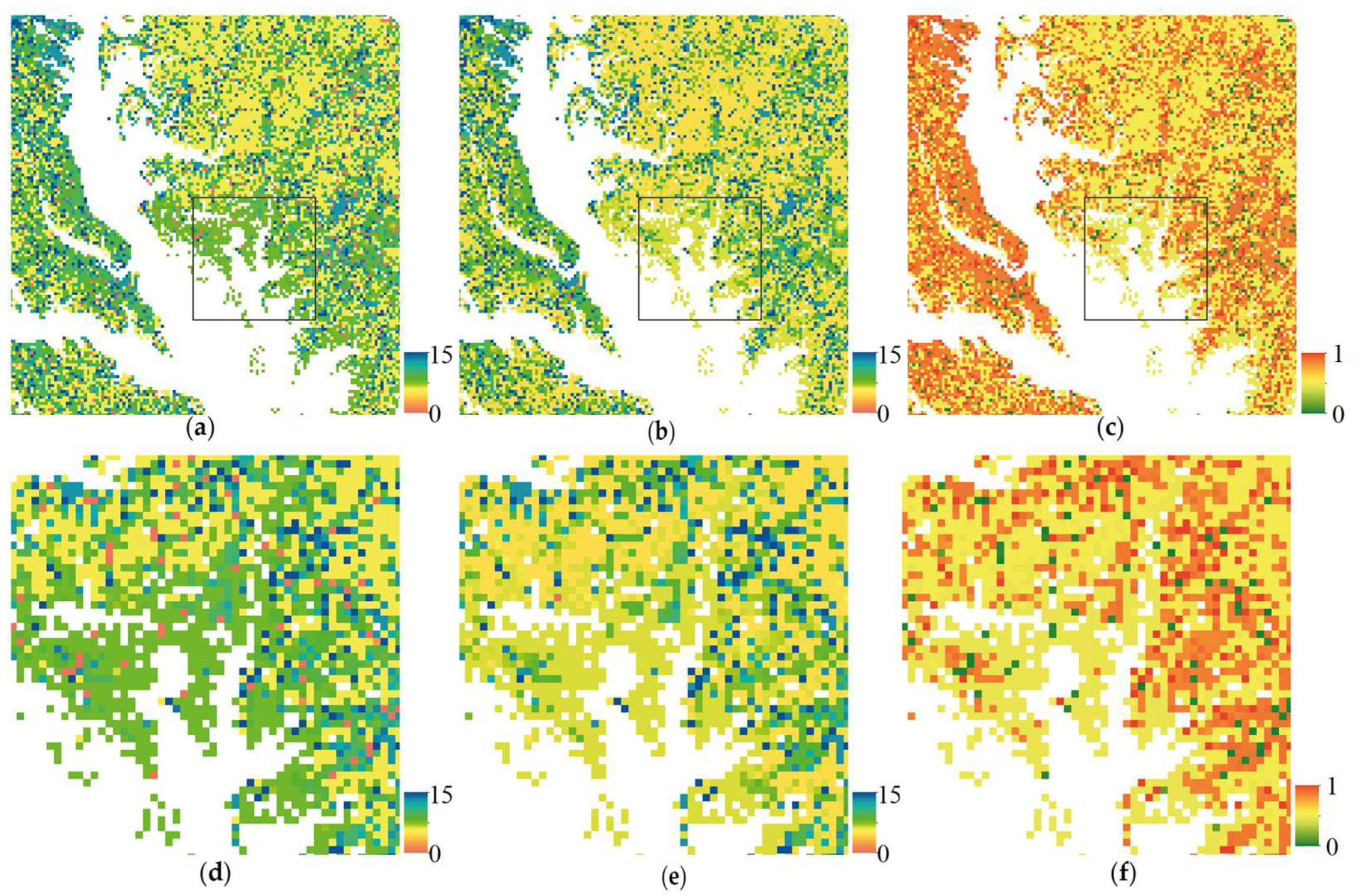

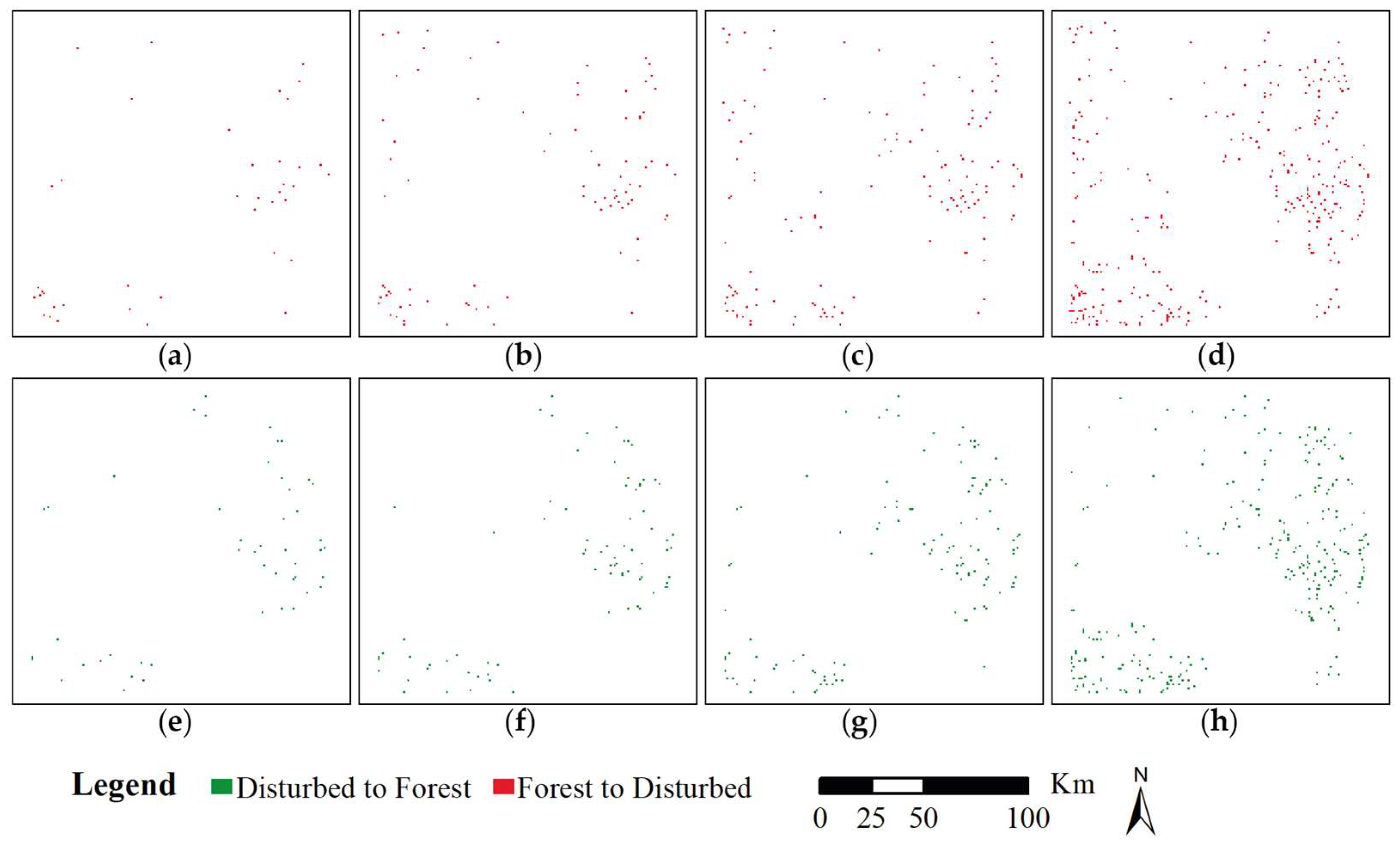
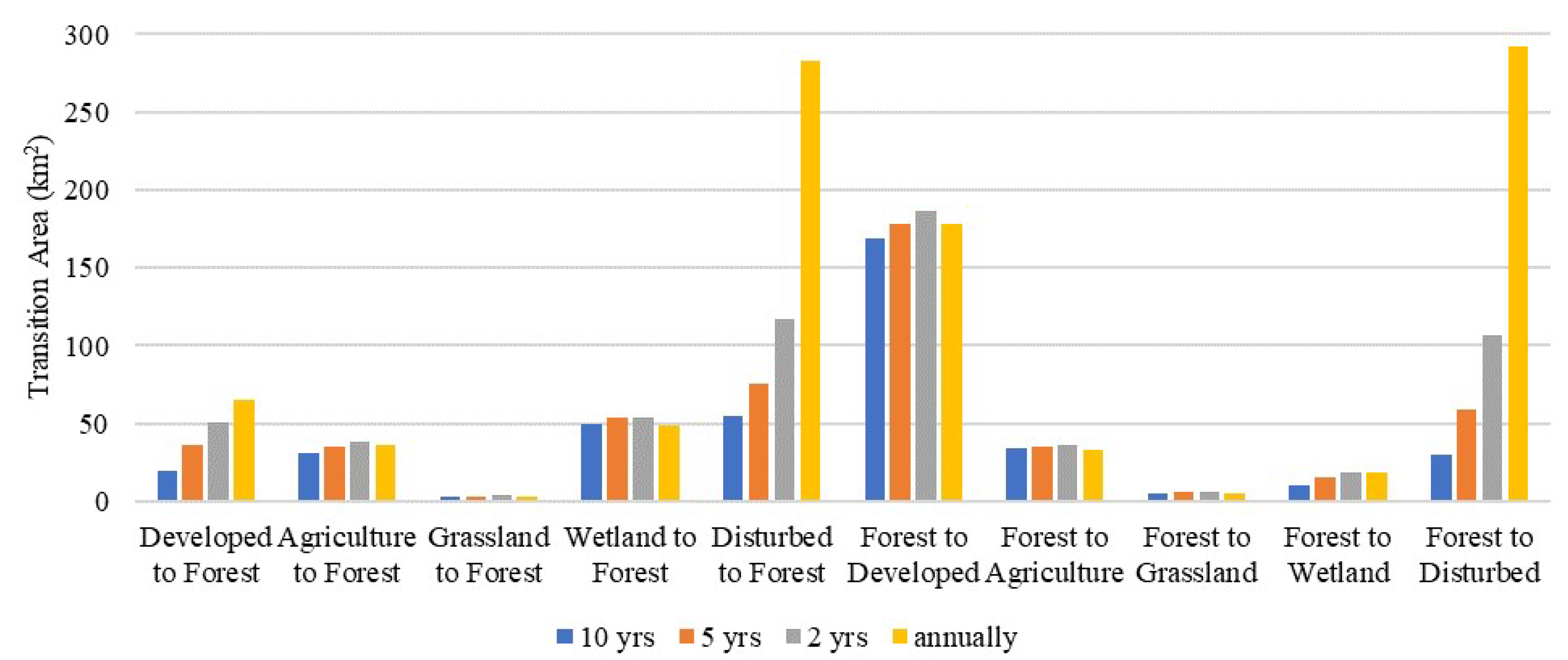

| From Class 2001 | To Class 2011 | ||||||
|---|---|---|---|---|---|---|---|
| Developed | Agriculture | Grassland | Forest | Wetland | Disturbed | Sum Area (2001) | |
| Developed | 1269 | 20 | 1 | 20 | 3 | 4 | 1316 |
| Agriculture | 122 | 5509 | 5 | 31 | 1 | 22 | 5689 |
| Grassland | 3 | 4 | 11 | 3 | 0 | 0 | 22 |
| Forest | 168 | 34 | 5 | 6193 | 10 | 30 | 6442 |
| Wetland | 25 | 2 | 1 | 50 | 1643 | 8 | 1728 |
| Disturbed | 21 | 63 | 1 | 55 | 6 | 3 | 149 |
| Sum Area (2011) | 1609 | 5633 | 23 | 6351 | 1663 | 67 | 15,346 |
© 2020 by the authors. Licensee MDPI, Basel, Switzerland. This article is an open access article distributed under the terms and conditions of the Creative Commons Attribution (CC BY) license (http://creativecommons.org/licenses/by/4.0/).
Share and Cite
Diao, J.; Liu, J.; Zhu, Z.; Li, M.; Sleeter, B.M. Substantially Greater Carbon Emissions Estimated Based on Annual Land-Use Transition Data. Remote Sens. 2020, 12, 1126. https://doi.org/10.3390/rs12071126
Diao J, Liu J, Zhu Z, Li M, Sleeter BM. Substantially Greater Carbon Emissions Estimated Based on Annual Land-Use Transition Data. Remote Sensing. 2020; 12(7):1126. https://doi.org/10.3390/rs12071126
Chicago/Turabian StyleDiao, Jiaojiao, Jinxun Liu, Zhiliang Zhu, Mingshi Li, and Benjamin M. Sleeter. 2020. "Substantially Greater Carbon Emissions Estimated Based on Annual Land-Use Transition Data" Remote Sensing 12, no. 7: 1126. https://doi.org/10.3390/rs12071126
APA StyleDiao, J., Liu, J., Zhu, Z., Li, M., & Sleeter, B. M. (2020). Substantially Greater Carbon Emissions Estimated Based on Annual Land-Use Transition Data. Remote Sensing, 12(7), 1126. https://doi.org/10.3390/rs12071126








